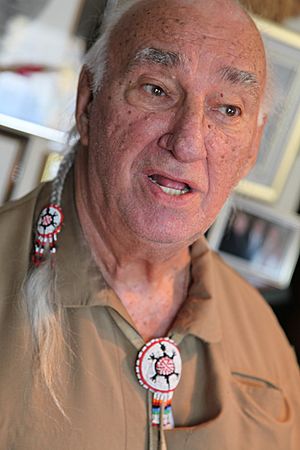Max Gros-Louis facts for kids
Quick facts for kids
Max Gros-Louis
|
|
|---|---|
| Oné Onti | |

Max Gros-Louis in 2011
|
|
| Grand Chief of the Huron-Wendat First Nation | |
| In office 1964–1984 |
|
| In office 1994–1996 |
|
| In office 2004–2008 |
|
| Personal details | |
| Born |
Magella Gros-Louis
August 6, 1931 Wendake, Quebec |
| Died | November 14, 2020 (aged 89) Quebec City, Quebec |
Max Gros-Louis (born August 6, 1931, died November 14, 2020) was an important leader and businessman from Quebec, Canada. His birth name was Magella Gros-Louis, and his traditional name was Oné Onti. For many years, he served as the Grand Chief of the Huron-Wendat First Nation. He also helped start and lead many groups that worked to protect the culture and rights of Indigenous peoples in Canada.
Early Life and Beginnings
Max Gros-Louis was born on August 6, 1931, in Wendake, Quebec. This place was then known as the Huron Village Indian Reservation. His father, Gerard Gros-Louis, was a vice-chief of the Huron-Wendat Nation for 16 years. Max's family had lived in Huron for a long time.
He went to school in Loretteville but left when he was 16. As a young person, he received the Wendat name Oné Onti, which means "paddler."
At first, Gros-Louis earned a living by hunting, fishing, and trapping on the traditional lands of the Huron-Wendat First Nation. Later, he became a guide, helping others on similar trips. He also worked as a surveyor and a traveling salesperson.
He opened a small shop called "Le Huron." There, he sold traditional crafts like snowshoes and moccasins. He also managed a dance company. Traveling for his business, he met many other Indigenous communities. This led him to become involved in politics.
Political Leadership
In 1964, Max Gros-Louis was chosen as the Grand Chief of the Huron-Wendat Nation in Wendake. At that time, the reservation was quite small. Gros-Louis worked to make it much larger. He also helped set the borders of his nation's ancestral lands with the Innu people.
Between 1965 and 1976, he helped create the Association des Indiens du Québec. He was also a vice president and treasurer for this group. Gros-Louis helped create the "Indians of Canada" exhibit at Expo 67, a big world's fair in Montreal. In 1970, he became Quebec's representative to the National Indian Brotherhood.
Gros-Louis wrote a book about his life called First Among the Huron, published in 1973. In 1983, he spoke for First Nations people from Quebec at important meetings about Indigenous laws in Canada. As Chief, he started programs to create businesses and jobs in his community.
His first time as chief ended in 1984. However, he returned to the role three years later and served until 1996. Gros-Louis also worked as a Director and Vice Chief for the Assembly of First Nations for ten years.
He was elected Grand Chief of the Huron-Wendat Nation again in 2004. He stayed in this position until 2008, when Konrad Sioui was elected. During his time as chief, he worked to expand the nation's land and improve its standing around the world. He also worked to bring attention to unfair treatment of Indigenous people.
Throughout his political career, he served in important roles. He was a national vice-chief of the Assembly of First Nations. He was also a vice-chief of the North American Assembly of First Nations and the World Assembly of First Nations.
Later Years and Honors
In 2012, a book about Max Gros-Louis's life, called Max Gros-Louis Le corbeau de Wendake, was published by Alain Bouchard.
Gros-Louis received many important awards. He was made an officer of the National Order of Quebec. In December 2015, he was also awarded the Order of Canada, which is one of the highest honors in Canada. He also received awards from Belgium and France, including the Legion of Honour.
Max Gros-Louis passed away on November 14, 2020, in Quebec City, at the age of 89.
See also
 In Spanish: Max Gros-Louis para niños
In Spanish: Max Gros-Louis para niños

